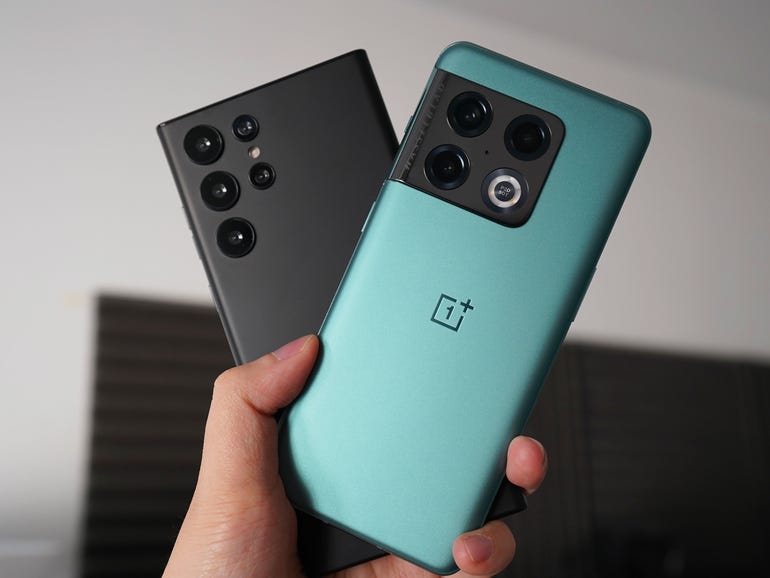
OnePlus 10 Pro vs. Samsung Galaxy S22 Ultra: Android flagships compared
Last Updated on April 15, 2022 by Admin
[ad_1]
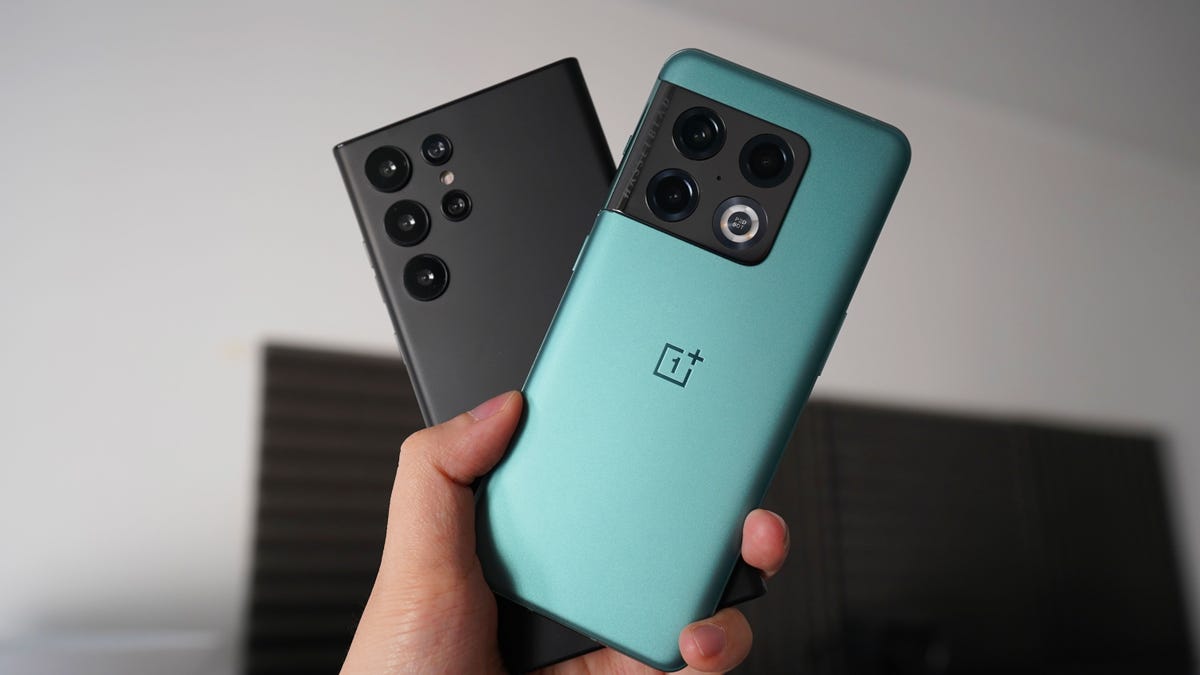
June Wan/ZDNet
Choosing the right Android is a much more convoluted task than with iPhones when it comes to buying a smartphone. In the realm of Google-powered handsets, there are choices aplenty. Samsung, OnePlus, Motorola, TCL, and Google themselves offer a range of phones that make sales associates scratch their heads when customers ask, “What Android phone should I buy?”.
But if you want a top-of-the-line flagship, the list narrows down to the newly released OnePlus 10 Pro, Samsung’s Galaxy S22 Ultra and Google Pixel 6 Pro. ZDNet’s Matthew Miller compared the OnePlus to Google’s Pixel 6 Pro earlier this month. So for this analysis, we’ll be pitting OnePlus’s $899 flagship against Samsung’s, which cost $1,199.
The two offer complete, utilitarian smartphone experiences, with prices to match. But with a $300 price gap, you’ll want to know all the differences before settling on one.
Design
|
OnePlus 10 Pro |
Samsung Galaxy S22 Ultra |
|
|
Display |
6.7-inch AMOLED with 120Hz (LTPO 2.0) |
6.8-inch AMOLED with 120Hz (LTPO 2.0) |
|
Weight |
201g |
228g |
|
Biometrics |
In-display optical fingerprint sensor, face unlock |
In-display ultrasonic fingerprint sensor, face unlock |
|
Colors |
Emerald Forest, Volcanic Black |
Phantom Black, Phantom White, Burgundy, Green |
|
Camera |
48MP wide, 50MP ultra-wide, 8MP telephoto, 32MP front |
108MP wide, 12MP ultra-wide, 10MP telephoto (10x), 10MP telephoto (3x), 40MP front |
|
IP rating |
IP68 on the US T-Mobile version only |
IP68 on all models |
The OnePlus 10 Pro and Samsung Galaxy S22 Ultra represent two different approaches to industrial design. The former takes a burdenless route, with rounded corners and a lightweight body (201g), making the OnePlus surprisingly comfortable to hold, even with a protective case attached. Comparatively, the S22 Ultra has pulled design cues from its Note sibling, boosting a sharp-cornered and boxy form factor. This provides a broader canvas for you to interact with, at the cost of feeling wider in the hand.
Still, both devices sport similarly-sized displays. The OnePlus 10 Pro has a 6.7-inch AMOLED panel, capable of flexing between 1 to 120Hz. The Samsung Galaxy S22 Ultra has a slightly larger 6.8-inch AMOLED panel that also features LTPO 2.0 tech for adaptive refresh rates. No matter which of the two you end up with, you’ll be getting a vibrant, sharp-looking, and color-accurate display experience.
In both cases, the phones are using Gorilla Glass Victus material, providing enhanced durability from drops and bumps. The back covers are also layered with a satin, matte finish, reducing the fingerprint smudges and marks that typically plague phones with glossy exteriors.
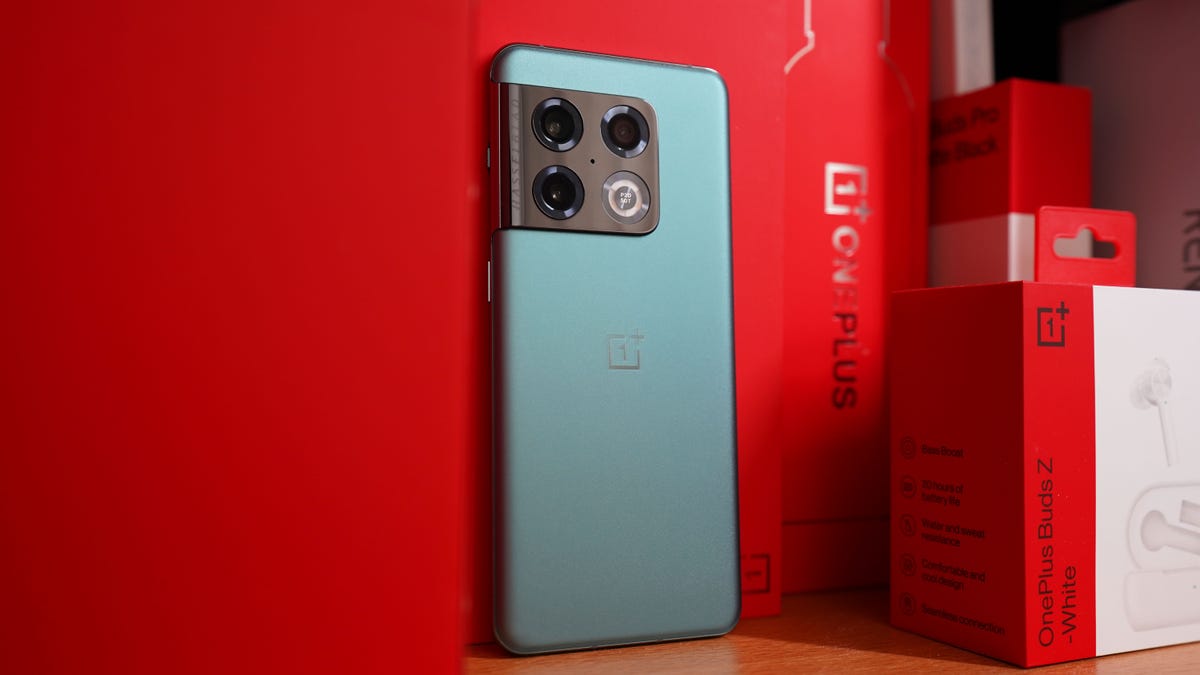
OnePlus 10 Pro in Emerald Forest.
June Wan/ZDNet
Under the screens lie two key differences: the front-facing cameras and in-display fingerprint sensors. Since the dawn of hole-punch cameras, OnePlus has kept its front-facing shooter in the upper left corner of its displays. That’s compared to the Samsung’s, which is now housed at the center. Both cameras are small enough to remain unobtrusive and, in general, are effectively better than the iPhone’s notch design.
The OnePlus 10 Pro uses an in-display optical fingerprint sensor versus the ultrasonic sensor of the Samsung. In this case, the latter is the better of the two, provided it uses 3D mapping to precisely register your fingerprints. Whether you’re In the dark or your fingers are wet, the Samsung’s ultrasonic sensor is more likely to unlock successfully than the OnePlus. That’s not to say that OnePlus’s counterpart isn’t comparable, though. It’s just as speedy and uses light reflections rather than pressure to scan your finger.
Also: Everything you need to know about the OnePlus 10 Pro
Other hardware differences include the side-mounted alert slider on the OnePlus, similar to that of the iPhone. Flicking between the three clicks sets the phone to silent, vibrate, and sound. While the S22 Ultra lacks the physical toggle, it makes up for it with its native S Pen, siloed on the bottom left of the device. Whether you’re an artist, student, or one who prefers writing over typing, the S Pen stylus is a Samsung experience that no other manufacturer has been able to replicate.
Lastly, let’s talk about water and dust resistance. While not every OnePlus 10 Pro is certified with an IP68 rating — only the US T-Mobile variant is — it can be inferred that the device will sustain normal splashes and dives. On the other hand, no matter which Samsung Galaxy S22 Ultra you buy, the device will come with the IP68 rating. It’s one of the other features that justifies its higher price tag.
Performance
|
OnePlus 10 Pro |
Samsung Galaxy S22 Ultra |
|
|
Processor |
Qualcomm Snapdragon 8 Gen 1 |
Qualcomm Snapdragon 8 Gen 1 |
|
RAM |
8GB/12GB RAM |
12GB/16GB RAM |
|
Storage |
128GB, 256GB |
128GB, 256GB, 512GB, 1TB |
|
Connectivity |
5G (sub-6 GHz) |
5G (mmWave and sub-6 GHz) |
|
Battery |
5,000mAh with 80W charging (65W in North America) |
5,000mAh with 45W charging |
Both the OnePlus 10 Pro and Samsung Galaxy S22 Ultra are equipped with the latest Qualcomm Snapdragon 8 Gen 1 processors on the performance side. Going head to head in Geekbench 5 testing, the Samsung beats out the OnePlus with its single-core score of 1,232 (versus 985) but with a multi-core score of 3,433 (versus 3,446). Basically, graphics-intensive games, multitasking, and loading day-to-day apps are non-issues for either device.
Still, if you seek a phone with as much RAM and storage as possible, the S22 Ultra is the way to go. It comes in 12GB and 16GB RAM configurations, alongside storage sizes that range from 128GB to 1TB. The OnePlus trails behind with only the 8GB/128GB variant available in the US. There’s a 12GB/256GB model available for purchase for international users.
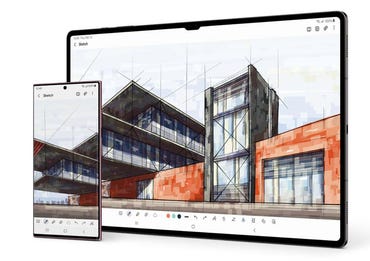
The Samsung Galaxy S22 Ultra can mirror onto a larger display for dual-screen functionality.
Image: Samsung
With both units operating on their respective skins over Android 12, the software experience boils down to your preference. While OnePlus’s OxygenOS is no longer the “stock Android” alternative, it’s still free of bloatware, and animations flow effortlessly across apps. Samsung’s OneUI software is a little more stacked, with native Samsung apps pre-installed and a bevy of widgets and features. While the learning curve is wider for the Galaxy device, it leaves a greater impression that you’re getting what you’re paying for.
In terms of connectivity, the OnePlus and Samsung are headlined by 5G. However, there is a discernible difference in how capable and fast each device is. Most likely to save on cost, the OnePlus 10 Pro only supports sub-6 GHz, the slower but widely available flavor of 5G. It can also link to Verizon’s C-band network. For Samsung’s case, the S22 Ultra supports sub-6 GHz and mmWave, allowing the device to dial into the fastest 5G bands — if your area has the appropriate antennas.
Also: What is 5G? Everything you need to know
A dependable battery is needed to sustain the amount of power that you’re getting from either smartphone. That’s why both are packed with 5,000mAh cells that, from our testing, have proven to keep them running all day long. And when you need to top up, OnePlus takes a demanding lead with 80W SuperVOOC charging (65W for North American folks) that can take the 10 Pro from 0% to 100% in less than 30 minutes. That’s compared to the 45W limit of the Samsung. With wireless charging, the OnePlus also has the advantage thanks to its 50W speeds versus the S22 Ultra’s 15W.
Camera
There’s no denying that we rely on our smartphone cameras more than ever. Whether it’s to capture a special moment, take a group selfie, or record a performance, having a reliable point-and-shoot is a must. Fortunately, both the Samsung Galaxy S22 Ultra and the OnePlus 10 Pro take steady and high-quality pictures and videos.
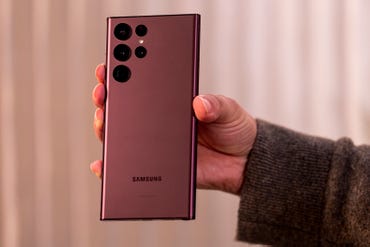
The Samsung Galaxy S22 Ultra has a quad-camera setup, with the main being a 108MP shooter.
Image: Samsung
The Samsung Galaxy S22 Ultra leads the way with its quad-camera setup at the rear, including a 108MP main lens, 12MP ultra-wide, and two 10MP telephoto lenses for natural-looking depth of field and focused zoom shots. In terms of capturing portrait shots, Samsung’s camera systems have proven to be among the best, accurately blurring out the background of subjects while keeping the front sharp and clear.
Comparatively, the second generation of OnePlus’s Hasselblad-tuned camera has also demonstrated that it’s capable of hanging with the big dogs. The 10 Pro sports a lesser 48MP main lens, a 50MP ultra-wide, and an 8MP telephoto. While not as vivid or punchy as the Samsung, the OnePlus camera produces more natural-looking stills, which some of you may prefer.
Also: OnePlus 10 Pro vs Google Pixel 6 Pro
Both phones have Pro modes built-in that allow you to fine-tune the ISO, shutter speed, white balance, and focus of the respective camera systems. Additionally, you’re able to shoot RAW photos, which process imagery in the most minimal manner so that you can adjust the coloring in post. Clearly, no matter which phone you buy, you’ll be getting a camera that’s suited for photographers of all skill levels.
With video recording, both units can capture up to 8K footage. The only difference is that the OnePlus 10 Pro shoots 8K in 30 frames per second, while the Samsung Galaxy S22 Ultra shoots in 24fps. Depending on what your cinematic standards are, this deviation may be enough to sway towards one phone over the other. Optical image stabilization effectively affects both camera systems, but if you want the best for zooming, the Samsung takes the win.
Unique features
Lastly, let’s talk about the unique features that come with each phone — starting with the Samsung Galaxy S22 Ultra. The biggest unique selling point is the aforementioned S Pen. With a decade of experience refining the stylus experience (via the Galaxy Note), the S Pen is more useful than ever. Besides doodling and taking notes with its 4,096 levels of sensitivity, the stylus can be used as a Bluetooth remote for presentations, taking pictures from afar, or gesture controls.
For business and productivity, the S22 Ultra can also be hooked up to an external monitor to activate Samsung DeX. With it, the Galaxy smartphone replicates an almost full-fledged desktop experience. The OnePlus 10 Pro does not have this feature, making it less appealing to traveling consumers.
While the OnePlus 10 Pro doesn’t have as many party tricks, it does come with one practical benefit that beats out the Samsung: a charger included in the box. Whether you qualify for the 80W or 65W SuperVOOC charging, users looking to take advantage of the faster speeds can do so right out of the box. On the contrary, the S22 Ultra only comes with a USB-C cable. The 45W charging adapter must be purchased separately.
Bottom line
To recap, the OnePlus 10 Pro sells for $899 for the 8GB/128GB model. If you reside in North America, that’s the only option that is available. The Samsung Galaxy S22 Ultra sells for $1,199 for the 12GB/128GB model, with the highest 1TB version priced at $1,599. While the Samsung costs $300 more, you may find some of its standout features worth the money, like the S Pen and cameras. Samsung’s software update policy is also one year longer than OnePlus’s, so you can expect to receive software improvements for longer. But if you can do without the fillers and fluff, the OnePlus 10 Pro is a compelling Android flagship that’s priced just right.
Alternatives
Open to other smartphone prospects? Consider these ZDNet-tested devices:
[ad_2]
Source link




